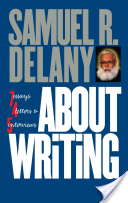

What: About Writing, by Samuel R. Delany, is a book of writing advice that includes seven essays, four letters, and five interviews. Two essays are ones I go back to over and over again, “Thickening the Plot,” and “Characters.”
Who: People who will enjoy this book include all manner of writers, as well as anyone interested in Delany’s own awesome fiction.
When: You should read this when you’re feeling uninspired about your own writing or if you want some assurance that “writing to discover” is as valid an approach as plotting things out thoroughly.
Why: Delany is one of the foremost SF writers of our time. His work speaks not just to those beginning to write, but those well along their path. If, like me, you love his fiction, you’ll find About Writing sheds new light on those works.
Where and how: Read it someplace quiet, where you have space to stare off into the distance, thinking about what Delany has said. Read it straight through or else do what I do and dip in at various places. No matter what angle your approach takes, it’ll be rewarding.
...
 I’ve been teaching an advanced workshop that’s been a lot of fun. I gave them one of my favorite texts, an issue of Swamp Thing by Alan Moore called “Pog.” You might want to read it before proceeding on to the discussion of it. Go ahead, I’ll wait.
I’ve been teaching an advanced workshop that’s been a lot of fun. I gave them one of my favorite texts, an issue of Swamp Thing by Alan Moore called “Pog.” You might want to read it before proceeding on to the discussion of it. Go ahead, I’ll wait.
I picked that text because it has a high degree of emotional impact. It was a great starting point for talking about how to create that in a piece of fiction. In discussing how Moore achieved that, we realized that it is primarily constructed through the characters. While it’s nice to see the images, they are not the primary source of the impact.
Here are the five ways that impact is created:
So what takeaways for character building can one draw from this? Are there axioms that can be applied in one’s own writing? Of course there are, and here’s the list:
...
Want access to a lively community of writers and readers, free writing classes, co-working sessions, special speakers, weekly writing games, random pictures and MORE for as little as $2? Check out Cat’s Patreon campaign.

"(On the writing F&SF workshop) Wanted to crow and say thanks: the first story I wrote after taking your class was my very first sale. Coincidence? nah….thanks so much."

(science fiction, short story) Shi was currently female. She had chosen to present as an eleven-year-old girl, a slim, short shape that she had found disarmed most older people. Although there was a small percentage who found it off-putting. “Creepy,” one had called it, trying to explain the aversion. “An adult mind in a kid’s body? You just know too much.”


This site is protected by reCAPTCHA and the Google Privacy Policy and Terms of Service apply. This site is a participant in the Amazon Services LLC Associates Program, an affiliate advertising program designed to provide a means for sites to earn advertising fees by advertising and linking to Amazon.com.